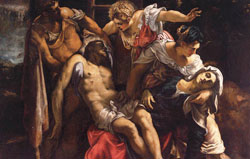Supercharging the Creative Process:
A Roadmap Toward Better Art
Part 6, The Flow of Creativity
If you stand back and consider the creative process, you will notice it starts with the vague and moves to the finite. For instance, in building a house we start by a vague idea of what we want. We start to narrow it down and as we do, our idea starts to coalesce. We work out the best area to build the house and how many bedrooms, etc. Then we have to actually acquire the space upon which to build. Then we have to assemble an architect and people who will build the house. But before the architect can start, he will need from us an overall theme or motif for the house. Prairie style? Ranch? Colonial?
Craftsman? Then we must sift through various sequences and arrangements of rooms to create a blueprint. Next comes the artistic treatment with color palettes, flooring, lighting, finishes, etc. Then comes the actual building using lumber and nails and other objects of construction.
Leave out a step and you get huge problems. Include them all and the creative process flows from vague ideas to an honest-to-god house with squirrels running across the roof.
Creation starts with ideas and ends with objects. It starts with the infinite and ends with the finite. You could say the creative process is like an inverted pyramid. But really there is more to it than that.
Geometric shapes have been used as philosophic machines for thousands of years, especially circles, spirals and pyramids.
In a circle, we start at the top, move all the way down and back up again. At the top is traditionally where the beginning and the end meet.
As a practical example, let’s again take building a home but this time in more detail.
So again, we start at the top with both nothing. You have nothing, but you also have the whole entire world from which to draw inspiration and ideas. So from that broad base, you pull materials for your research.
You might study photos of other homes, you might take your inspiration from nature as car designs often do. You might build an underground home as do some animals in the wild. You might take the atom as inspiration and build a geodesic home. In short, you have the entire world of nature and history to select ideas from, and even beyond that you have the power of imagination.
So you are truly starting with both nothing and infinity where you gather pertinent data. This is the stage of research or homework. This is the stage of zero and infinity.
The next step down is thought or planning. You must study, read and analyze. You must look and consider options. You weigh the pros and cons. You investigate advantages and disadvantages and look at your options.
The product of this level is direction and decisions that will guide your subsequent actions. Planning would include a notion of where you want to live—in what city? On a hilltop or by the water? In town or out in the suburbs? Perhaps the school district is important if you are raising kids. Perhaps proximity to a job site or to other family members, parks, shopping or entertainment. What are the parameters of the house? Number of rooms and bathrooms? How many square feet?
Now that you have some decisions and direction to follow, your next step is to look around for a lot on which you can build. In the context of a game, this step is the selection of a space or playing field. You can’t play a game without some kind of playing field created from matter, energy, space and time.
Then comes a team of living players. You’re going to need an architect and later on you are going to need a builder and various crews swinging hammers, installing plumbing and electrical wire. Upon the playing field must come life. And that’s the keynote of this step.
The first thing such people will need is a unifying concept for what is to be created. What species, motif or theme will this home embody? And so we have the stage whereby we must establish a unifying theme or identity.
Examples of unifying themes would include tudor, rustic, ranch style, modern, futuristic, contemporary. Here is motif. Here is unifying identity. There may be other unifying decisions needed here, such as quality. Is it to be contractor grade or a quality fit for royalty? What species of home is this anyway?
Now, with the homework done and analyzed, decisions made and a direction set, the playing field located and mapped, players found and a team selected, the next step is the fundamental action of organization, beginning with the overall design of the house itself. Do you want all the bedrooms together? How many spaces in the garage? Will you have a home theatre? What about a pool? Do you want the master bedroom separated from the kids bedrooms? You have to organize your plan. Will there be an open kitchen? Front entrance or side entrance? In what sequence will a visitor experience the house as an art form? Will the front door open into sweeping living area, a hallway or a foyer? Will the kitchen be centrally located or at the rear of the house? Is it to be one story or two? Various sequences and arrangements will be tried to learn what will work best.
Now with the basic organization established, it’s time to get creative. Here you begin to ornament the basic plan. This level is aimed at the aesthetics of your future home. Call it creativity. How will you ornament this home to make it beautiful? Brass details? Beveled glass? Stone work? Retro styling? Will you work with existing trees or plant new ones? You (or someone) must select colors and textures and think about the final look you want to achieve. Here, designer touches and architectural flourishes establish a trademark look. This is the hairstyle, cosmetics and fashionable accessories that create a sense of handsome beauty.
Then, and only then, are you ready to create the symbolic blueprint of your home. At this level you actually begin to create at the level of symbology. And what is a symbol anyway?
A symbol is something with three qualities:
1) Mass,
2) Meaning,
3) Mobility.
A chess piece is a symbol. The knight represents a real knight. The chess piece has mass. It has weight. It has meaning -- it represents the abilities of a knight on horseback. And it has mobility: you can move it around.
A blueprint is a symbol. It has mass (the weight of the paper it’s printed on). It has great meaning to a builder. And it has mobility because you can roll it up and throw it in the truck. And unroll it again at Starbucks.
Here too will be construction documents, budgets, planning and critical path all written using symbols. Lists of materials will be created for purchasing. Electrical plans use descriptive symbols denoting junctions, outlets and fuse boxes. Letters are symbols. Numbers are symbols.
At this point we’ve come from nothing/infinity, down through thought, space, selected a team, established unifying characteristics, established the organization of the home, injected creativity, and now the process has congealed into symbology which has actual mass.
In this way, we’ve followed an upside down pyramid structure moving from vague, nebulous nothing down through all the various stages of creation, continually coalescing as we go, down to lightest shades of finite matter with weight and mass.
But the funny thing is of course we aren’t done yet. And in fact the complete philosophical machine also includes a circle superimposed over the top of the inverted pyramid, because where do we go now that we’re at the bottom? Back up to the top.
These two symbols, the circle and triangle, working together go back thousands of years, so this is nothing that I made up myself. The top of the circle begins at the 12 ‘o clock position, the place where infinity and nothing meet. It comes around following the exact path we just traced down to the bottom where we are dealing with objects, or really symbols.
So with blueprints and construction documents done, we are now halfway round the circle. We started at midnight and with blueprint in hand we now stand at 6 o’clock.
Let’s retrace our steps quickly to see how far we’ve come. We started at the top where everything and nothing meet. We started with nothing. But more truly we started with everything which is in infinite amount.
The steps again were infinity (our starting point). Then we moved through the band of thought. Next we established the space where all would take place. Then we populated that playing field by creating teams of living people thus adding the necessary element of life. After that, we come to a nexus where unifying themes are established. This step serves bring unity to the project cementing its parts into a whole. Then we organized and grouped elements of our plan. Then we injected creativity by inventing ways to ornament the bare bones for a sense of beauty. Finally we arrive a the level of symbolic creation and blueprint for our home.
Next comes the actual construction of the home itself. So in fact, all the parts we’ve discussed so far are merely the countdown to actual launch or groundbreaking.
Looking again at this process of creation, we started at the top with infinity and progressed to the bottom of the curve in a count down of 8 steps. By coincidence, the symbol for infinity “∞” just happens to be an 8 on its side. So it is appropriate we begin our countdown of 8 steps with the number 8.
8. Infinity 7. Thought 6. Space 5. Life 4. Species 3. Organization 2. Creativity 1. Symbols
This philosophic machine is very useful in its conception. I did not invent it. I simply figured out how to use the sequence to bolster the creative process.
Next: Part 7, Tracing the Creative Path


















